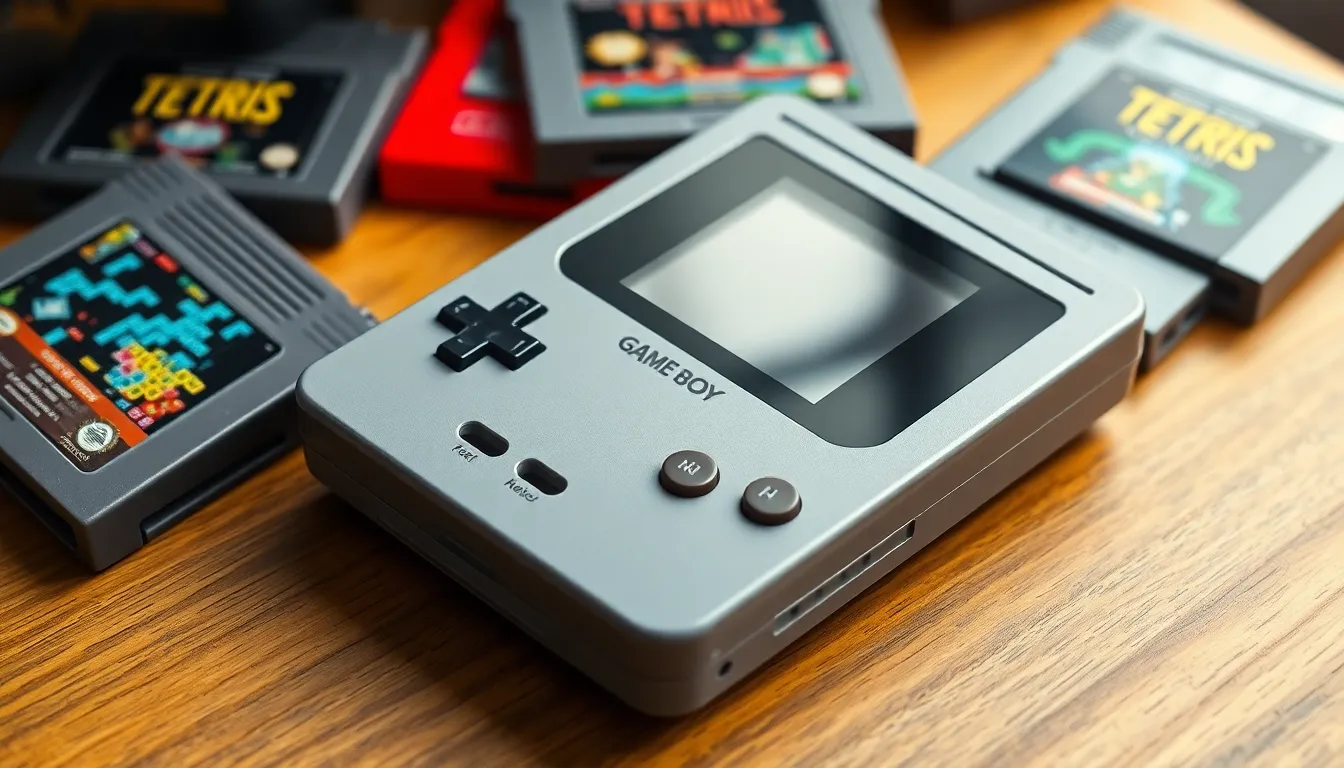Table of Contents
ToggleThe Game Boy revolutionized handheld gaming when it launched in 1989, captivating players of all ages. This iconic device not only introduced gaming on the go but also laid the groundwork for future portable consoles. With its simple yet effective design and a library of unforgettable titles, it quickly became a staple in the gaming community.
As the years went by, the Game Boy evolved, giving rise to several iterations like the Game Boy Color and Game Boy Advance. Each version brought new features and advancements, solidifying its place in gaming history. Exploring the journey of the Game Boy reveals not just the evolution of a beloved device but also the impact it had on the gaming industry and culture.
Overview of Game Boy History
The Game Boy debuted in 1989, marking a pivotal moment in handheld gaming. Designed by Nintendo, its compact form and monochrome display appealed to a wide audience. Initial models featured a 160×144 pixel screen, operated on four AA batteries, and provided approximately 10 to 30 hours of gameplay, ensuring portability and extended play.
The release of the Game Boy Color in 1998 introduced a color display, enhancing the gaming experience. It featured a 256-color palette, improved processing power, and backward compatibility with original Game Boy titles. Sales reached over 118 million units worldwide, solidifying its position in gaming history.
In 2001, the Game Boy Advance launched, providing a more powerful 32-bit processor and a screen capable of displaying 240×160 pixels. This iteration supported a vast library of games, including standout titles like “Pokémon Ruby and Sapphire.” The Game Boy Advance SP followed in 2003, incorporating a clamshell design and a front-lit screen.
The Game Boy series’ legacy continued with the Game Boy Micro in 2005, emphasizing portability and style, although it offered a limited library due to its lack of backward compatibility. Over the years, Game Boy systems collectively sold over 200 million units, showcasing their enduring popularity in the gaming realm.
The Birth of Game Boy

Game Boy emerged as a pivotal device in handheld gaming history. With its debut in 1989, it showcased Nintendo’s innovative approach to portable play.
Development and Concept
Development of Game Boy began in 1988 under the leadership of Gunpei Yokoi. The design focused on simplicity and battery life to appeal to a broad audience. Engineers built the device with a compact chassis that housed a reflective LCD screen. They prioritized ergonomics, ensuring comfortable use over extended periods. Game Boy featured a robust library with titles like “Tetris,” which emphasized puzzle-solving, thus attracting gamers of all ages.
Release and Initial Reception
Game Boy launched on April 21, 1989, in Japan, followed by releases in North America and Europe later that year. Initial reception surpassed expectations, with sales reaching nearly a million units within the first few weeks. Critics praised its affordability and portability. Consumers appreciated the long battery life, allowing 10 to 30 hours of gameplay. Game Boy quickly became a cultural phenomenon, establishing a strong foundation for future handheld gaming devices.
Evolution of Game Boy Models
The Game Boy has undergone significant changes since its initial release, with each model bringing innovations that enhanced the gaming experience.
Game Boy Color
Released in 1998, the Game Boy Color marked a pivotal moment in handheld gaming. It featured a 2.2-inch color display with a resolution of 160×144 pixels, doubling the graphical capabilities of its predecessor. This model utilized a custom 8-bit CPU, allowing it to support color graphics and improving overall performance. Backward compatibility enabled players to enjoy original Game Boy titles, while new titles like “Pokémon Gold” and “Silver” maximized its color capabilities. The Game Boy Color sold over 30 million units globally, solidifying its place in gaming history.
Game Boy Advance
The Game Boy Advance launched in 2001, introducing advanced technology to handheld gaming. This model featured a 32-bit ARM7TDMI processor, delivering enhanced graphics and smoother gameplay. Its larger 2.9-inch screen supported a resolution of 240×160 pixels, providing a more immersive experience. The Game Boy Advance supported a diverse library of games, including “The Legend of Zelda: The Minish Cap” and “Metroid Fusion,” showcasing its capabilities. The device sold over 81 million units worldwide, proving its popularity and critical acclaim within the gaming community.
Impact on Gaming Culture
The Game Boy significantly shaped gaming culture, establishing a foundation for handheld gaming and fostering a community of passionate players. Its innovations and game library influenced various aspects of the gaming industry.
Cultural Significance
The Game Boy became a cultural icon during the late 20th century. It popularized gaming on-the-go, making video games accessible beyond home consoles. Families and friends gathered to compete in titles like “Tetris,” which promoted social interaction. The device’s portability spawned gaming trends, allowing players to experience games in unconventional settings, such as on public transportation. The Game Boy’s impact extended to merchandise and media, with characters from its games becoming recognizable figures in pop culture.
Influence on Contemporary Handheld Consoles
The Game Boy’s influence resonates in modern handheld consoles. Features such as portability, user-friendly interfaces, and extensive game libraries set industry standards. Devices like the Nintendo Switch and PlayStation Vita drew inspiration from its form factor and multiplayer capabilities. The Game Boy’s success also encouraged other manufacturers to enter the handheld market, resulting in diverse offerings that catered to various gaming preferences. Its legacy remains evident in how players engage with handheld technology today.
Game Boy Games and Titles
The Game Boy hosted a diverse array of games that defined handheld gaming. Memorable titles and franchises emerged, captivating players worldwide.
Iconic Games
Iconic games brought the Game Boy to life, showcasing its potential. Key titles include:
- Tetris: Launched with the Game Boy, this puzzle game became synonymous with the device and sold over 30 million copies.
- Pokémon Red and Blue: Released in 1996, these titles initiated the Pokémon phenomenon, leading to a franchise that generated over $100 billion in revenue.
- Super Mario Land: Released in 1989, this platformer introduced Mario to handheld gaming and sold more than 18 million copies.
- The Legend of Zelda: Link’s Awakening: This 1993 release provided an engaging action-adventure experience, earning critical acclaim and influencing future Zelda games.
- Metroid II: Return of Samus: This 1991 title expanded the Metroid series, introducing new gameplay mechanics and selling approximately 1.3 million copies.
These games established the Game Boy as a leader in handheld gaming, attracting players of all ages.
Legacy of Game Boy Games
The legacy of Game Boy games influenced future gaming trends. Notable aspects include:
- Genre Diversity: The Game Boy’s library encompassed various genres, including platformers, RPGs, and puzzle games, setting a precedent for future handheld systems.
- Portable Multiplayer: Games like “Tetris” and “Pokémon” encouraged social interaction, popularizing multiplayer experiences on the go.
- Franchise Foundations: Iconic franchises such as Pokémon and Mario continued to flourish across platforms, with enduring popularity and new releases.
- Cultural Impact: Game Boy titles left a lasting impression on pop culture, with characters and gameplay reflected in other media, merchandise, and spin-offs.
- Innovation: The success of Game Boy games prompted advancements in design and technology, influencing modern handheld gaming devices and their libraries.
This legacy continues to shape the gaming industry, ensuring the Game Boy’s place in history remains significant.
The Game Boy’s journey from its 1989 debut to its lasting legacy illustrates its monumental impact on gaming. It not only redefined handheld gaming but also created a vibrant community of players who embraced its unique offerings. With a library of iconic titles and innovative designs, the Game Boy set the stage for future handheld consoles. Its influence is still felt today in modern gaming devices, proving that the spirit of the Game Boy lives on. As it continues to inspire new generations of gamers, its place in gaming history remains secure.







